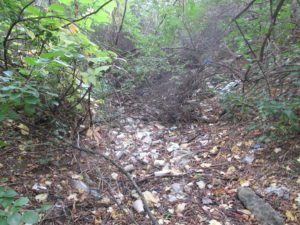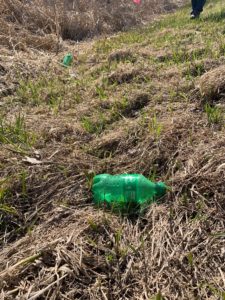 With Earth Day taking place on Friday, April 22, I wanted to write a “feel-good’ blog about all the positive steps people are taking to make our environment a better place. There have been great strides in improving our environment, not only in the United States but worldwide. However, as I look around my local community, I realize we have a lot more work to do. The exceptional amount of plastic litter I see along roadsides and in our wetlands and waterways has been weighing heavily on my mind lately. A great deal of the litter appears to be “single-use” plastics (such as soda and water bottles) that will never biodegrade in our lifetimes. Plastic is everywhere – in our homes, offices, schools, where we shop, and even in our cars. It is critical to our modern living and has been a great benefit to our society in many ways. It’s a wonder how we ever used to live without it. At the same time, it is damaging to the environment. Plastics that don’t break down end up littering our wetlands and waterways, and many ultimately end up in our ocean. According to the National Oceanic and Atmospheric Administration (NOAA), it is believed that there may be as much as 8 million metric tons of plastic in the ocean. I started doing some research to find out more about the plastic pollution problem and what we can do about it. Some of what I learned was alarming, but I think it is important to share the information in order to get people thinking about ways they can minimize the number of single-use plastics in their daily lives.
With Earth Day taking place on Friday, April 22, I wanted to write a “feel-good’ blog about all the positive steps people are taking to make our environment a better place. There have been great strides in improving our environment, not only in the United States but worldwide. However, as I look around my local community, I realize we have a lot more work to do. The exceptional amount of plastic litter I see along roadsides and in our wetlands and waterways has been weighing heavily on my mind lately. A great deal of the litter appears to be “single-use” plastics (such as soda and water bottles) that will never biodegrade in our lifetimes. Plastic is everywhere – in our homes, offices, schools, where we shop, and even in our cars. It is critical to our modern living and has been a great benefit to our society in many ways. It’s a wonder how we ever used to live without it. At the same time, it is damaging to the environment. Plastics that don’t break down end up littering our wetlands and waterways, and many ultimately end up in our ocean. According to the National Oceanic and Atmospheric Administration (NOAA), it is believed that there may be as much as 8 million metric tons of plastic in the ocean. I started doing some research to find out more about the plastic pollution problem and what we can do about it. Some of what I learned was alarming, but I think it is important to share the information in order to get people thinking about ways they can minimize the number of single-use plastics in their daily lives.
Following are some interesting historical facts on plastics according to the Science History Institute (SHI):
- The first synthetic polymer was invented by John Wesley Hyatt in 1869. A New York firm made an offer of $10,000 for anyone that could make a substitute for ivory since the popularity of billiard balls puts a strain on the supply of ivory.
- The first fully synthetic plastic, meaning it contained no molecules found in nature, was invented by Leo Bakelite in 1907 while he was searching for a synthetic substitute for shellac, a natural electrical insulator, to meet the needs of the rapidly electrifying United States.
- Plastic production increased by 300% during WWII in the United States. The surge continued after the war ended.
- The reputation of plastic started to suffer in the 1970s and 1980s when concerns about non-biodegradable plastic waste increased. This initiated the start of recycling in the 1980s.
- The reputation of plastics fell further in more recent decades with concerns about potential threats to human health from additives in plastic such as bisphenol A (BPA).

Most plastics do not decompose, but eventually break down into smaller pieces. Depending on the type of plastic, it can take an estimated 20 to 500 years to degrade. No one knows for sure, but below are some estimates on degradation timelines for the most common single-use items are as follows:
- Plastic bags – 20-100 years
- Disposable coffee cups – 30 years
- Soda bottles – 450-1,000 years
- Shampoo bottles – 100 years
- Plastic straws – 100-500 years
- Six-pack plastic rings – 400 years
- Plastic water bottles – 450 years
- Disposable diapers – 250-500 years
- Coffee pods – 500 years
- Plastic toothbrushes – 500 years
- Bottlecaps – 100-500 years
You might think that most plastics are being recycled in the United States and probably most advanced countries, so what is the big concern? The concern is that recycling rates still remain relatively low. So, how is the United States track record on recycling compared to other countries? I would say average. According to 2015 data from the Organization for Economic Cooperation and Development (OECD), the United States had an overall recycling rate of only 35%. Compare that to other countries such as Turkey and Chile who recycle a mere 1% of their total waste, the U.S. seems to have a pretty good record. However, countries such as Germany led the pack with a 65% recycling rate. South Korea, Austria, Slovenia, Sweden, and Switzerland were also leading with recycling rates above 50%. On a positive note, all countries, except for Chile and Turkey, were shown to have collectively increased their recycling rates by 42%. However, it is clear that more plastic continues to be discarded rather than recycled.
What changes can we make in our daily behaviors to prevent so much plastic waste? Although it would be nearly impossible to never use another single-use plastic item again, I encourage you to commit to at least a few small changes to reduce your use. Here are some suggestions:
- Instead of single-use plastic bottles, carry a stainless-steel reusable water bottle with you. There are many types of reusable water bottles that are available for purchase that are better for your health, keep your drink cold all day, and save you money.
- Don’t bother with a drinking straw, whether plastic or paper. Just drink straight from the cup. Also, forego the plastic lids.
- Paper or plastic? Tell them neither, I have my own bags. Bring your own reusable (washable) bags to the grocery store (and other stores where permitted).
- Plastic bags and wrap are typically not allowed in household recycling bins; however, some stores have a drop-off for recycling plastic bags. Find the closest location to you and regularly drop off all clean, dry plastic bags. Places such as Lowe’s, Kohls, Walmart, Pick-n-Save, and Metro Market all accept plastic bags and wrap.
- Reuse plastic bags for multiple shopping trips.
- Instead of buying plastic-wrapped foods, buy fresh food or grow some of your own food.
- Dispose of food waste in a compost bin to reduce the use of plastic garbage bags.
- Purchase grocery items that come in glass or paper rather than plastic.
- If your community does not currently have a recycling program, find the closest recycling center to take your plastic and other recyclable materials.
- Don’t be a litterbug. Leave only your footprints behind.
- Check out the WDNR’s recycling website to find out where you can take various recycled materials: https://dnr.wisconsin.gov/topic/Recycling.
- Be part of an Adopt-a-Highway program or other clean-up programs in your community. You could also simply pick up trash during walks in your neighborhood.
raSmith provides opportunities for its employees to clean up the environment and enjoy nature including:
- The Milwaukee Riverkeeper’s Annual Spring Cleanup along an adopted one-mile stretch of the Menomonee River running through Hart Park. This year the cleanup takes place on Saturday, April 23. Additional events are scheduled for May 25 and July 21.
- The Adopt-a-Highway program along a segment of Highway 164 (Pewaukee Road) from Watertown Road to Capitol Drive.
Contact Us
Our ecologists have helped numerous clients with hundreds of ecological projects over the past two decades. For questions about our ecological services, please contact our Senior Wetland Ecologist/WDNR-Assured Delineator, Tina Myers at (262) 317-3389 or tina.myers@rasmith.com (Brookfield, Wisconsin office).
